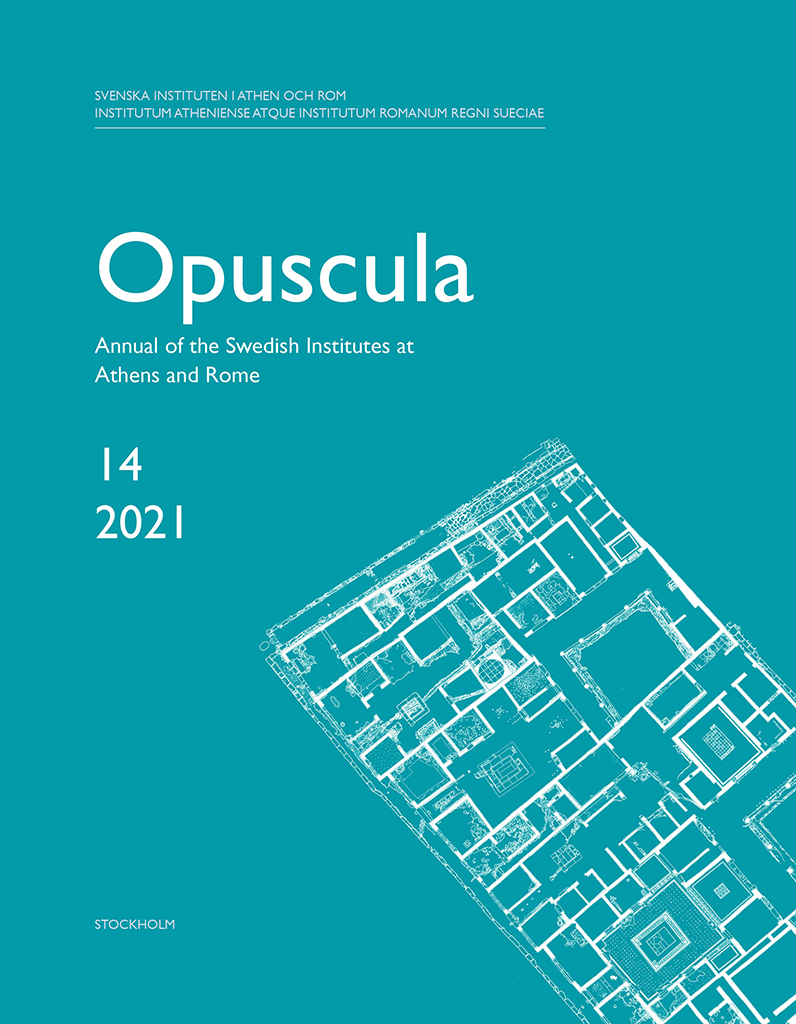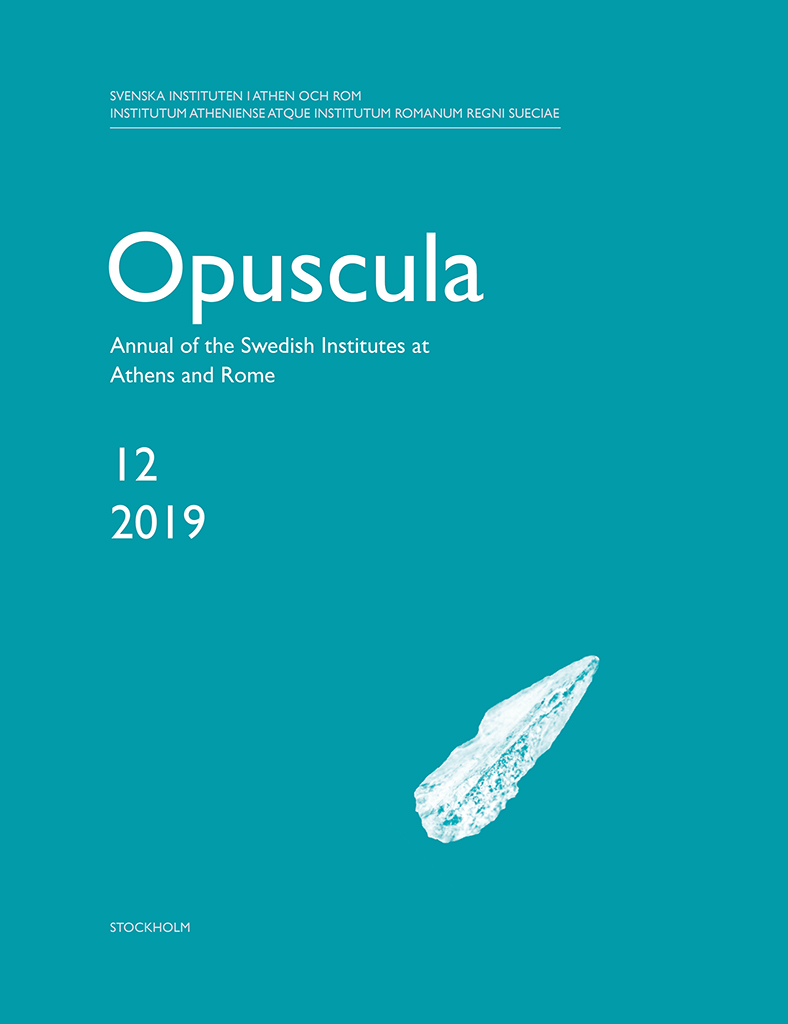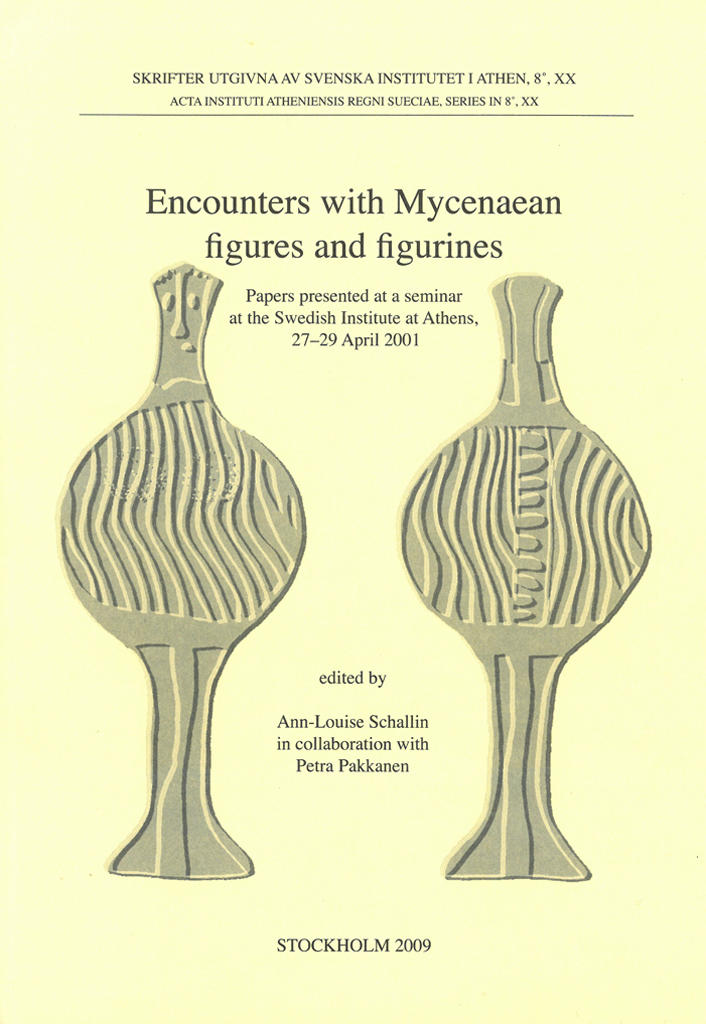Opuscula 16 is published by the Swedish Institutes at Athens and Rome. Distributed by Eddy.se AB. View volume at ERIH PLUS. All content available with open access. The New Swedish Cyprus Expedition (The Söderberg Expedition): Excavations at Hala Sultan Tekke autumn 2021 and spring 2022. Preliminary results By Peter M. Fischer & Teresa Bürge with contributions by Rainer Feldbacher, Kirsi O. Lorentz, Bianca Casa, Natalie M. Branca, Yuko Miyauchi, Sila Kayalp, Maria Nectaria Antoniou, Svetlana Gasanova, Valentina Vassallo, Rahaf Orabi, Panagiotis Ioannou & Sorin Hermon Abstract In 2021 and 2022, the 13th and 14th seasons of excavations at the Late Bronze Age site of Hala Sultan Tekke were carried out in Area A, and as a result of these investigations numerous tombs were found. These tombs were threatened by farming. Four magnetic anomalies, indicated in the 2017 survey magnetometer map, were investigated. They represent three tombs, L198, TT, and UU, and the probable Offering Pit SS-S. The minimum number of individuals (MNI) in Pit Tomb L198, which contains only secondary burials, is six. They are associated with 21 ceramic vessels of which a few were imported from Anatolia. Chamber Tomb TT was completely excavated and contained a minimum of 25 individuals and 78 objects. Among these are 47…
Opuscula 15 is published by the Swedish Institutes at Athens and Rome. Distributed by Eddy.se AB. View volume at ERIH PLUS. The New Swedish Cyprus Expedition (The Söderberg Expedition): Excavations at Hala Sultan Tekke 2020 and 2021. Preliminary results By Peter M. Fischer & Teresa Bürge, with contributions by B. Placiente Robedizo, C. Eriksson, K.O. Lorentz, N.M. Branca, B. Casa, Y. Miyauchi, S.A.M. Lemmers, S. Kayalp, V. Vassallo, S. Florindi, S. Gasanova, S. Hermon, L. Avial Chicharro, E. Peri & B. Clark Abstract In 2020 and 2021, the eleventh and twelfth seasons of excavations at the Late Bronze Age city of Hala Sultan Tekke were carried out in the cemetery of Area A. Based on indications provided by a large-scale magnetometer survey, two tombs exposed by intensive farming were located, Tombs RR and SS. The excavation of Tomb RR, which had started in 2018, was concluded. The total minimum number (MNI) of skeletons in this tomb, of which most were incomplete and disarticulated, is estimated at 137. In addition to clay figurines, seals and scarabs, objects of ivory, as well as jewellery of gold, silver, bronze, faience and carnelian, the inhumations are associated with more than 100 intact or complete ceramic…
Opuscula 14 is published with open access. Printed edition distributed by Eddy.se AB. Also available at Amazon.com, Adlibris, and Bokus. View volume at ERIH PLUS. Palaepaphos-Teratsoudhia Tomb 288 (c. 1650 BC–c. 1200 BC) By Vassos Karageorghis (University of Cyprus) & Efstathios Raptou (Department of Antiquities, Cyprus), with appendices by Alexander Donald, Gisèle Clerc & Anna Spyrou Abstract This paper presents a new tomb complex of the Late Bronze Age at Palaepaphos-Teratsoudhia in south-west Cyprus. Although looted, Tomb 288 yielded a representative repertoire of funerary gifts, including seals and scarabs, ranging chronologically from the very beginning of the Late Bronze Age to Late Cypriote IIC, roughly from 1650 to 1200 BC. Tomb 288 has characteristics which are typical of Late Bronze Age tomb architecture in Cyprus and well known in the Paphos region, as well as aspects which have not previously been observed in any necropolis of the period, such as the large central “pillars” which support the roof in Chambers A and B. The tomb’s finds comprise representative examples of the ceramic production of Palaepaphos for a period of some 400 years and illustrate the wealth of this region during the whole of the Late Bronze Age. The tomb is…
All content of Opuscula 13 is available with open access. Printed edition distributed by Eddy.se AB. Also available at Amazon.com, Adlibris, and Bokus. View volume at ERIH PLUS. The New Swedish Cyprus Expedition 2019: Excavations at Hala Sultan Tekke (The Söderberg Expedition). Preliminary results, with contributions by L. Recht, B. Placiente Robedizo, C. Eriksson, L. Andersson, M. Svensson, L. Avial Chicharro, S. Hermon, M. Polig & D. Kofel By Peter M. Fischer (University of Gothenburg, Sweden) & Teresa Bürge (Austrian Academy of Sciences) Abstract The tenth season of excavations at the Late Bronze Age city of Hala Sultan Tekke was carried out in four areas: City Quarter 1 (CQ1), CQ4, City Wall 1 (CW1), and Area A (Tomb RR). The excavations in CQ1 provided additional information on the pre-LC IIIA occupation of the city. Stratum 3 which can be dated to the LC IIC (13th century BC) was further exposed. For the first time in the city even older phases, Strata 4 and 5, were found. These are tentatively dated to the LC I–II (15th to 14th century BC). In CQ4 numerous storage areas were exposed, which belong to a large compound. There is also evidence of production of textiles…
All content of Opuscula 12 (2019) is available with open access. Printed edition distributed by Eddy.se AB. Also available at Amazon.com, Adlibris, and Bokus. View volume at ERIH PLUS. The New Swedish Cyprus Expedition 2018: Excavations at Hala Sultan Tekke (The Söderberg Expedition). Preliminary results, with contributions by J. Tracz and D. Kofel By Peter M. Fischer (University of Gothenburg, Sweden) & Teresa Bürge (Austrian Academy of Sciences, Austria) Abstract During the ninth field season at the Late Bronze Age city of Hala Sultan Tekke, excavations in City Quarter 1 (CQ1) continued and brought to light industrial and domestic structures belonging to three phases of occupation (Strata 3–1) dating to the 13th and 12th centuries BC (LC IIC–IIIA). Finds of more than half a ton of copper slag together with remains of furnaces and tuyères indicate intensive urban copper production. There is also evidence of textile production in CQ1. A magnetometer survey of roughly 23 ha resulted in the discovery of another large city quarter (CQ4) between CQ1 and Area A (the cemetery) with regularly arranged stone-built compounds of imposing dimensions intersected by streets. Several massive walls are faced with ashlar slabs which distinguishes this quarter from the industrial and…
Opuscula 11 (2018) is available for purchase at Amazon.com, Adlibris, Bokus and bokorder.se. Distributed by eddy.se ab. The New Swedish Cyprus Expedition 2017: Excavations at Hala Sultan Tekke (The Söderberg Expedition). Preliminary results By Peter M. Fischer (University of Gothenburg) & Teresa Bürge (Austrian Academy of Sciences). With contributions by Magda Ausiayevich, Bebelyn Placiente Robedizo, Victor Barrera Alarcón, Laerke Recht & Dominika Kofel. Abstract During the eighth field season at the Bronze Age city of Hala Sultan Tekke, excavations in City Quarter 1 (CQ1) exposed massive industrial and domestic structures belonging to three phases of occupation (Strata 3–1) dating to the 13th and 12th centuries BC (LC IIC–IIIA). Georadar survey, penetrating to a maximum depth of approximately 1 m, guided the excavation of walls of Strata 1–2, both of which were destroyed by conflagration. Excavations 1.5–2 m below the surface and also below the maximum penetration depth of the radar revealed a heretofore buried phase of occupation with substantial architectural units. For the first time, massive Stratum 3 structures with a markedly different building technique were exposed. Copper smelting installations, much ash and slag, and storage facilities also belong to this phase of occupation. Additional excavations guided by results from…
Opuscula 10 (2017) is now available for purchase at Amazon.com, Bokus.com, Adlibris.com, and Bokorder.se. The New Swedish Cyprus Expedition. Excavations at Hala Sultan Tekke (The Söderberg Expedition). Preliminary results By Peter M. Fischer & Teresa Bürge. With contributions by Laerke Recht, Dominika Kofel, David Kaniewski, Nick Marriner & Christophe Morhange Abstract In the seventh season at the Bronze Age city of Hala Sultan Tekke excavations continued in City Quarter 1 (CQ1) where georadar indicated stone structures to the south of the area excavated in 2010–2012. Massive domestic structures, which belong to three phases of occupation (Strata 1–3), were exposed. Both the most recent Stratum 1, and Stratum 2 were destroyed in a conflagration. The three phases are preliminarily dated to the 13th and 12th centuries BC. Excavations were also carried out in Area A, roughly 600 m to the south-east of CQ1. Seven circular anomalies indicated by our geomagnetic survey were excavated. Two were pits of modern date, and three were identified as Late Cypriot wells. Another anomaly turned out to represent a rich Late Cypriot offering pit with figurines and more than 60 ceramic vessels. Amongst the Mycenaean vessels are several “chariot kraters” and a large vessel with the…
Opuscula 9 (2016) is now available for purchase and free download at bokorder.se. Also available at Amazon.com, Amazon.de, Bokus.com and Adlibris.com. The New Swedish Cyprus Expedition 2015. Excavations at Hala Sultan Tekke. Preliminary results By Peter M. Fischer & Teresa Bürge. With a contribution by Dominika Kofel Abstract In 2015 the sixth season of the renewed excavations at the Bronze Age city of Hala Sultan Tekke continued in the compound which was exposed in Area 6W in 2013–2014. Further evidence of textile processing was found. The results of another ground-penetrating radar (GPR) survey in 2014 indicated a new city quarter west of the former. Excavations were initiated there in 2015 and parts of the remains of a large compound were exposed. Two occupational phases, Strata 1 and 2, could be determined, both of which were destroyed in a conflagration. Further excavations were carried out in Area A, 550 m to the east of Area 6W and close to the mosque of Hala Sultan Tekke. In 2014 more than 80 circular anomalies were indicated by our geomagnetic survey supported by GPR. Twelve of them were excavated in 2015. Most of them turned out to be backfilled wells of which the fills…
Opuscula 6 (2013) is now available for purchase and free download at Bokorder.se. Also available at Amazon.com, Amazon.de, Bokus.com and Adlibris.com. Textual evidence for Aegean Late Bronze Age ritual processions By Jörg Weilhartner Abstract In the Aegean Late Bronze Age there exists rich iconographic evidence for the ritual practice of processions, demonstrating the practice’s importance within Mycenaean official cult. In contrast, due to the nature of the Linear B documents which are the records of the palace administration referring to particular aspects of the palace economy, hardly any explicit textual information about processions in Mycenaean times is available. Among the rare exceptions is the outstanding tablet Tn 316 from Pylos whose lexical items seem to point to a ritual of this kind. Moreover, the term te-o-po-ri-ja/*θεοφóρια (“the carrying of the gods”) is generally understood as the name of a religious festival in which a (terracotta) cult figurine representing a deity was carried in a procession. Some additional textual evidence on processions may be provided by terms ending in -po-ro/-φóρος. Along these lines, this paper argues that the term to-pa-po-ro may denote men whose description reflects activities they have performed in connection with processions. Similarly, it is suggested that the individuals…
Now available for purchase at Amazon.com, Amazon.de, Bokus.com, Adlibris.com. Distributed by Eddy.se AB. Encounters with Mycenaean figures and figurines. Papers presented at a seminar at the Swedish Institute at Athens, 27–29 April 2001 By Ann-Louise Schallin & Petra Pakkanen (eds.) This volume presents fourteen articles which discuss Mycenaean figurines from various points of view. They focus on different aspects of the figurines, elaborating on their function, contextual characteristics, production, use-life, classification, topography, and history of scholarship. The articles are based on papers given at a workshop at the Swedish Institute at Athens in April 2001 entitled ‘Cultic Space and Mycenaean Figurines’. The idea of having a workshop arose from the fact that several of the participants were involved at the time with the documentation of various figurine types from the so-called Potter’s Workshop at Mastos in the Berbati Valley in the Argolid. The number and variety of the Mycenaean figurines from Mastos is impressive, particularly as the excavation had covered only a small area. The excavator, Å. Åkerström, proposed that the site had a cultic function in addition to its role as a production centre. In order to better understand the characteristics and identity of Mastos, scholars were invited to…










